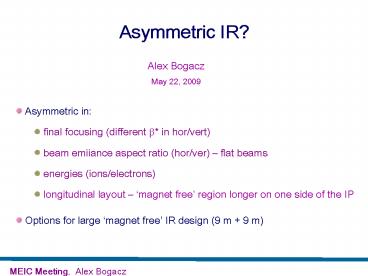Berkeley Lab Generic Presentation - PowerPoint PPT Presentation
1 / 10
Title:
Berkeley Lab Generic Presentation
Description:
longitudinal layout magnet free' region longer on one side of the IP ... The longest distance between the IP and the first quad is critical for FF quad apertures ... – PowerPoint PPT presentation
Number of Views:41
Avg rating:3.0/5.0
Title: Berkeley Lab Generic Presentation
1
Asymmetric IR?
Alex Bogacz May 22, 2009
- Asymmetric in
- final focusing (different b in hor/vert)
- beam emiiance aspect ratio (hor/ver) flat
beams - energies (ions/electrons)
- longitudinal layout magnet free region
longer on one side of the IP - Options for large magnet free IR design (9 m
9 m)
2
Longitudinally asymmetric detector
9o
Caldwell-type detector (see arXivhep-ex/
0407053v1)
CLAS12 space (fixed target program) 10 meter on
ion side Initial EIC detector cartoon about 8
meter on ion side
3
Magnet free region beam sizes
beta function evolution in a drift space
s - distance from the IP
beta function at the first FF quad (distance l
from the IP)
4
60 GeV Ions - IR (half)
b 5 mm
solenoid
IP
9 m
FF triplet
FF quads Lb50/100/50 cm G18/-18/18 kG/cm
5
60 GeV Ions - IR (half)
b 5 mm
FF doublet
FF triplet
FF quads Lb50/100/50 cm G18/-18/18 kG/cm
FF quads Lb50/50/50/50 cm G23/-25/10/-10 kG/cm
9 m
9 m
6
60 GeV Ions - IR (half)
b 5 mm
b 5 mm
FF doublet
FF triplet
9 m
9 m
7
MEIC Parameter Table Medium Energy
Yuhong Zhang
8
Large magnet free region IR (9m 9m)
manageable beam sizes at the first FF quad
(distance l from the IP)
9
Large magnet free region IR (9m 9m)
manageable beam sizes at the first FF quad
(distance l from the IP)
10
Conclusions
- Longitudinally asymmetric IR has no advantage
- The longest distance between the IP and the first
quad is critical for FF quad apertures - (9m 3m) IR as challenging as (9m 9m) IR
- Triplet vs Doublet FF Optics
- Same magnet apertures required
- Triplet focusing more compact
- Doublet focusing more suitable for interleaved
FFs for smaller beam crossing - Flat beams favorable, ex/ey 10
- Beam-beam interaction
- Luminosity optimization
- Asymmetric focusing (b) for flat beams
desirable, bx/by 10 - Initial focusing of larger emittance plane
results in minimized beam sizes in both planes - Manageable beam sizes on FF quads, sRMS 5mm































